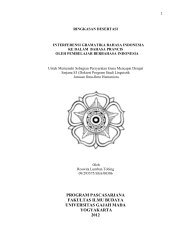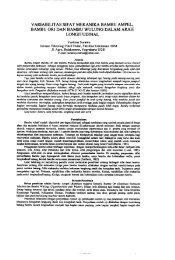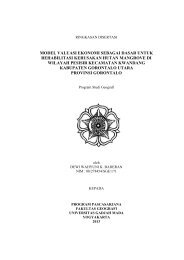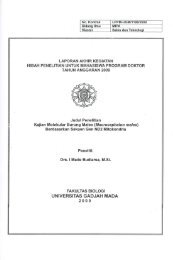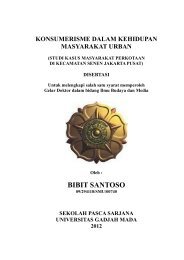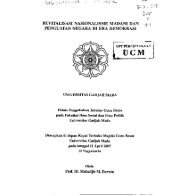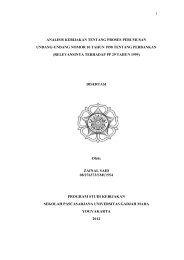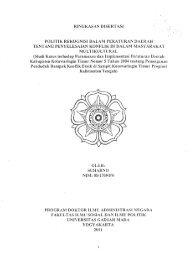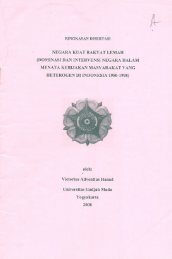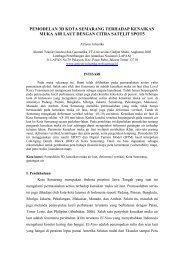DISERTASI - LIB Ugm - Universitas Gadjah Mada
DISERTASI - LIB Ugm - Universitas Gadjah Mada
DISERTASI - LIB Ugm - Universitas Gadjah Mada
Create successful ePaper yourself
Turn your PDF publications into a flip-book with our unique Google optimized e-Paper software.
<strong>DISERTASI</strong><br />
SINTESIS DAN PENGGUNAAN POLI-PROPILKALIKS[6]ARENA<br />
SEBAGAI ADSORBEN SERTA UJI AKTIVITASNYA SEBAGAI<br />
ANTIDOTUM KERACUNAN LOGAM BERAT<br />
SYNTHESIS AND UTILIZATION OF POLY-PROPYLCALIX[6]ARENES<br />
AS ADSORBENTS AND THE ACTIVITY TEST AS ANTIDOTE FOR<br />
HEAVY METAL POISONING<br />
Disertasi untuk memperoleh derajat Doktor dalam Ilmu Kimia pada<br />
<strong>Universitas</strong> <strong>Gadjah</strong> <strong>Mada</strong><br />
SUSY YUNITA PRABAWATI<br />
08/276069/SPA/188<br />
PROGRAM STUDI S3 ILMU KIMIA<br />
FAKULTAS MATEMATIKA DAN ILMU PENGETAHUAN ALAM<br />
UNIVERSITAS GADJAH MADA<br />
YOGYAKARTA<br />
2012<br />
i
SINTESIS DAN PENGGUNAAN POLI-PROPILKALIKS[6]ARENA<br />
SEBAGAI ADSORBEN SERTA UJI AKTIVITASNYA SEBAGAI<br />
ANTIDOTUM KERACUNAN LOGAM BERAT<br />
RINGKASAN<br />
165<br />
Kaliksarena merupakan salah satu bahan sintesis yang cukup potensial<br />
untuk dikembangkan. Kaliksarena termasuk dalam kelompok senyawa<br />
makromolekul yang mengandung cincin aromatis dalam suatu deret siklis yang<br />
dihubungkan oleh gugus metilen. Senyawa ini pertama kali ditemukan oleh Zinke<br />
pada tahun 1940-an dari reaksi terinduksi basa dari p-alkilfenol dengan<br />
formaldehida (Xin-Shen, 2006), tetapi arti penting dari penemuan tersebut tidak<br />
terlalu mendapat perhatian dari kalangan ilmuwan kimia selama hampir 30 tahun.<br />
Struktur senyawa kaliksarena sebagaimana ditunjukkan pada Gambar 1.1.<br />
Gambar R.1 Senyawa kaliks[4]arena (a), kaliks[5]arena (b),<br />
dan kaliks[6]arena (c)<br />
Perkembangan kimia makromolekul kemudian menjadi semakin pesat<br />
dalam dekade terakhir ini terutama setelah Gutsche mengungkapkan bahwa<br />
kaliksarena dapat berperan seperti “keranjang“ yang memungkinkan untuk<br />
digunakan sebagai penjebak berbagai senyawa baik berupa molekul atau ion<br />
(Gutsche, 1998). Bentuk geometri yang unik dan terdapatnya gugus-gugus aktif<br />
pada kaliksarena, memungkinkan senyawa ini dapat digunakan untuk berbagai<br />
keperluan.<br />
Secara umum, senyawa oligomer siklik kaliksarena baik berupa tetramer,<br />
heksamer, maupun oktamer, dapat diturunkan dari senyawa fenol, resorsinol atau
166<br />
pirogalol sebagai bahan dasar utama (Gutsche, 1998). Sintesis senyawa heksamer<br />
siklik kaliks[6]arena jauh lebih mudah dibandingkan dengan tetramer siklik<br />
kaliks[4]arena yang dikenal cukup rumit dalam proses pembuatannya. Sementara<br />
itu senyawa oktamer siklik kaliks[8]arena memiliki ukuran rongga molekul yang<br />
terlalu besar sehingga aplikasinya baik sebagai adsorben, ekstraktan, ionofor,<br />
maupun ligan relatif kurang.<br />
Keunikan dari struktur goemetri kaliksarena yang menyerupai keranjang<br />
memungkinkan senyawa ini berfungsi sebagai host-guest bagi molekul atau ion.<br />
Hal tersebut berbeda dengan kemampuan eter mahkota yang hanya menjebak ion,<br />
dan siklodektrin yang hanya menjebak molekul. Contoh penjebakan molekul oleh<br />
kaliksarena ditunjukkan oleh Kunsagi-Mate (2005) yang berhasil menggunakan<br />
garam kaliks[6]arena-Na heksasulfonat untuk menjebak p-nitro fenol. Lebih<br />
lanjut kaliks[n]arena juga dapat dimanfaatkan sebagai adsorben limbah zat warna<br />
(Ming-Chen, 2011) ataupun logam berat.<br />
Percobaan menggunakan senyawa kaliks[6]arena sebagai penjebak logam<br />
berat pernah dilakukan oleh Jumina dkk (2001) yaitu menggunakan p-(1-<br />
bromopropil)kaliks[6]arena sebagai penjebak logam Cr. Senyawa tersebut dapat<br />
menyerap logam Cr sebesar 24,8 %. Demikian pula Budiana (2005) pernah<br />
menggunakan p-t-butilkaliks[6]arena sebagai penjebak logam Pb dan hasil<br />
penelitiannya menunjukkan bahwa terjadi penyerapan logam Pb sebesar 39,57 %.<br />
Hasil-hasil penelitian terdahulu menunjukkan bahwa sisi aktif dari<br />
molekul kaliks[6]arena yang berperan penting pada proses adsorpsi, ekstraksi, dan<br />
kompleksasi yaitu adanya sejumlah gugus OH. Gugus-gugus -OH tersebut<br />
terletak berjajar membentuk struktur lingkaran dan eksistensi rongga molekul<br />
yang menyerupai bentuk seperti vas bunga atau mangkok sangat cocok digunakan<br />
sebagai ionofor. Selain mempunyai bentuk geometri molekul yang unik, variasi<br />
gugus fungsional juga dapat dilakukan secara hampir tak terbatas, baik pada<br />
lingkar bawah (lower rim) maupun lingkar atas (upper rim) dari kaliksarena.<br />
Secara umum terdapat dua strategi sintesis yang dapat dilakukan untuk<br />
meningkatkan afinitas kaliksarena dalam membentuk kompleks dengan ion<br />
logam. Pertama, mensintesis kaliksarena dengan memasukkan gugus-gugus
167<br />
ionofor yang bersifat polar seperti karboksil, amida, nitril, halida dan fosfat. Akan<br />
tetapi kalisarena dengan gugus-gugus tersebut tergolong dalam kalisarena yang<br />
larut dalam air, sehingga hal ini tidak sejalan dengan pemanfaatan kaliksarena<br />
sebagai adsorben yang tidak boleh larut dalam air. Alternatif lain yaitu dengan<br />
menggunakan strategi kedua, mensintesis kaliksarena yang mempunyai gugus<br />
sangat polar, akan tetapi untuk menekan kelarutannya di dalam air maka dapat<br />
dilakukan melalui immobilisasi kaliksarena pada suatu polimer atau mensintesis<br />
polimer kaliksarena (Tabakci, 2008).<br />
Berbagai penelitian telah dilakukan dalam hal mensintesis polimer<br />
kaliksarena ini, antara lain penelitian yang dilakukan oleh Trivedi dkk. (2002),<br />
telah melakukan sintesis kaliks[6]-hidroksiamida berbasis polimer yang<br />
mempunyai kemampuan luar biasa dalam menjebak ion logam Uranium,<br />
Thorium, dan Cerium. Sifat adsorpsi dari polimer kaliks[6]-1,4-crown juga telah<br />
dilaporkan oleh Yang dkk. (2005) terhadap kation-kation lunak seperti Cu(II),<br />
Co(II) dan Ni(II).<br />
Imobilisasi kaliksarena pada suatu polimer juga pernah dilakukan oleh<br />
Tabakci dan Mustafa (2008) dengan melakukan sambung silang antara kitosan<br />
dan kalis[4]arena membentuk polimer khelat. Hasil sintesis ini digunakan untuk<br />
adsorpsi kation logam berat dan anion dikromat. Hasil penelitian menujukkan<br />
bahwa polimer yang dihasilkan mempunyai kemampuan mengadsorp kation<br />
logam berat yang lebih tinggi (80-93 %) dibandingkan dengan kitosan (25-33%).<br />
Penelitian serupa masih dilakukan oleh Tabakci dan Mustafa (2008) yang<br />
melakukan immobilisasi kaliksarena-silika gel dan polimer yang dihasilkan juga<br />
mampu mengadsorpsi ion logam Cu(II) dengan hasil yang memuaskan.<br />
Penelitian yang dilakukan oleh Jumina dkk. (2007) menunjukkan<br />
kemungkinan memasukkan gugus alkenil seperti gugus alil pada lingkar bawah<br />
senyawa tetrahidroksi-kaliks[4]arena menghasilkan monoalilkaliks[4]arena.<br />
Adanya gugus pendonor elektron ini diharapkan memberi kontribusi yang tidak<br />
kecil untuk terjadinya kompleksasi dengan ion logam. Senyawa monoalilkaliks[4]arena<br />
ini kemudian oleh Utomo (2009) dipolimerisasi dalam kondisi<br />
asam menghasilkan polipropilkaliks[4]arena yang tidak larut dalam air.
168<br />
Pemanfaatan polimer ini sebagai adsorben ion logam berat Pb(II) dan<br />
Cr(III) ternyata menunjukkan kapasitas adsorpsi yang jauh lebih besar jika<br />
dibandingkan dengan monomernya. Penelitian selanjutnya dilakukan oleh<br />
Handayani (2011) juga berhasil mensintesis senyawa poli-5-alilkaliks[4]arena dan<br />
menunjukkan hasil yang cukup baik dalam menyerap kation-kation logam berat.<br />
Berdasarkan pada hasil-hasil penelitian sebelumnya, maka pada penelitian<br />
ini akan dilakukan pembuatan beberapa seri polimer polikaliks[6]arena.<br />
Pemilihan kaliks[6]arena sebagai monomer adalah dengan pertimbangan bahwa<br />
proses pembuatannya yang jauh lebih mudah dibandingkan kaliksarena lainnya<br />
dan senyawa ini juga mempunyai potensi yang cukup tinggi untuk dikembangkan.<br />
Pembuatan polimer kaliksa[6]arena diawali dengan memasukkan satu<br />
gugus alil dan dua gugus alil pada bagian bawah dari kaliks[6]arena. Pada proses<br />
polimerisasi, dengan adanya satu gugus alil maka akan terbentuk polimer linier,<br />
sementara dengan adanya dua gugus alil maka akan terjadi cross link antar<br />
molekul kaliks[6]arena.<br />
Dalam keadaan terpolimerisasi, maka lingkaran gugus OH dan rongga<br />
molekul kaliks[6]arena akan tersusun berjajar secara teratur membentuk struktur<br />
yang menyerupai terowongan. Situs-situs aktif tempat terjadinya pengikatan ion<br />
logam juga menjadi lebih banyak dan tersebar secara merata dalam suatu rantai<br />
polimer. Dengan demikian polimer yang dihasilkan diprediksikan akan<br />
mempunyai daya adsorpsi yang lebih tinggi terhadap kation-kation logam berat.<br />
Pada penelitian ini akan dilakukan pula modifikasi gugus fungsional OH<br />
yang tersisa dari senyawa aliloksikaliks[6]arena menjadi senyawa aliloksiesterkaliks[6]arena<br />
dan aliloksiasamkaliks[6]arena, yang selanjutnya juga dilakukan<br />
polimerisasi sehingga akan diperoleh polimer ester dan polimer asam<br />
kaliks[6]arena. Adanya gugus karbonil pada kedua senyawa tersebut<br />
dimungkinkan dapat meningkatkan kebasaan dari anion kaliks[6]arena yang<br />
terbentuk. Dengan demikian kemampuannya sebagai adsorben maupun antidotum<br />
logam berat menjadi lebih tinggi karena terjadi interaksi yang efektif antara<br />
gugus-gugus ester dan gugus karboksilat yang bersifat basa dengan logam-logam<br />
berat yang bersifat asam.
169<br />
Penelitian menggunakan senyawa kalik[6]sulfonat dan kaliks[8]sulfonat<br />
sebagai antidotum keracunan uranium pernah dilaporkan oleh Archimbaud dkk.<br />
(1994). Hasil penelitiannya secara in vivo menunjukan bahwa kaliks[6]arena<br />
mampu menurunkan kadar uranium dalam ginjal tikus.<br />
Senyawa makrosiklik turunan kaliksarena dapat berpotensi sebagai<br />
obat/antidotum keracunan logam berat umumnya dikarenakan terbentuknya<br />
senyawa pengkhelat antara gugus-gugus aktif seperti –OH, -SH, C=O, dan<br />
sebagainya dengan ion logam. Demikian pula struktur dan gugus-gugus aktif yang<br />
dimiliki oleh polimer kaliks[6]arena, juga diharapkan akan mampu membentuk<br />
khelat dan digmanfaatkan sebagi antidotum logam Cd, yang hingga saat ini belum<br />
banyak dilaporkan.<br />
Sintesis seri poli-kaliks[6]arena dilakukan melalui beberapa tahap yaitu :<br />
(1) pembentukan p-t-butlikaliks[6]arena dari p-t-butilfenol sebagai bahan dasar;<br />
(2) sintesis p-t-butil-37-monoaliloksi-38,39,-40,41,42-pentahidroksikaliks-<br />
[6]arena (kaliksarena 1); (3) sintesis p-t-butil-37-monoaliloksi-38,39,-40,41,42-<br />
pentaester-kaliks[6]arena (kaliksarena 2); (4) hidrolisis senyawa kaliksarena 2<br />
sehingga menghasilkan p-t-butil-37-monoaliloksi-38,39,-40,41,42-pentaasam-<br />
kaliks[6]arena (kaliksarena 3); (5) sintesis p-t-butil-37,40,di-aliloksi-38,39,41,42-<br />
tetra-hidroksi-kaliks[6]arena (kaliksarena 4); (6) polimerisasi terhadap kaliksarena<br />
1,2,3 dan 4 sehingga diperoleh polimer (PMK[6]H), (PMK[6]E), (PMK[6]A) dan<br />
(PDK[6]H). Karakterisasi terhadap produk dilakukan dengan spektrofotometri IR,<br />
1 H NMR dan 13 C NMR.<br />
Senyawa kaliks[6]arena diperoleh sebagai suatu berupa padatan putih<br />
dengan rendemen sebesar 65,47%. Dari penentuan titik lebur diketahui bahwa<br />
titik lebur produk yang dihasilkan adalah 370-372 o C (literatur 380 - 381 o C,<br />
Gutsche, dkk., 1989).<br />
Sintesis senyawa kaliksarena 1 dilakukan dengan mereaksikan p-t-<br />
butilkaliks[6]arena dalam pelarut aseton kering dan ditambahkan 0,414 gram<br />
K2CO3 dan 0,476 ml alil bromida. Perbandingan mol reaktan antara<br />
kaliks[6]arena : K2CO3 : alil bromida = 1 : 0,9 : 1,65 mol. Produk reaksi yang<br />
diperoleh berupa kristal berwarna kuning sebanyak 4,402 gram dengan rendemen
170<br />
yaitu 86,99%. Titik lebur produk yang dihasilkan adalah 178-180 o C. Hasil uji<br />
kelarutan produk diketahui pula bahwa produk larut dalam kloroform dan aseton<br />
tetapi tidak larut dalam metanol dan air.<br />
Identifikasi produk menggunakan spektrofotometer IR menegaskan bahwa<br />
gugus alil telah masuk ke dalam cincin benzena yaitu dengan munculnya serapan<br />
pada daerah 925 cm -1 yang sangat karakteristik untuk gugus fungsional C=C<br />
terminal dari suatu senyawa alil. Hasil analisis dari spektra 1 H NMR menunjukkan<br />
pola serapan dari jembatan metilen pada δ sekitar3,8 ppm muncul dengan<br />
kenampakan sepasang duplet dan satu singlet. Hal ini memberikan informasi<br />
bahwa konformasi dari senyawa kaliksarena 1 hasil sintesis adalah kerucut<br />
sebagian (partial cone). Identifikasi produk didukung pula dari hasil analisis<br />
spektra 13 C NMR.<br />
Reaksi esterifikasi terhadap kaliksarena 1 dilakukan dengan menggunakan<br />
reagen NaI dan etil-2-kloroasetat serta katalis K2CO3. Pada reaksi ini,<br />
digunakannya reagen NaI adalah untuk mengubah etil-2-kloroasetat menjadi etil-<br />
2-iodoasetat. Produk reaksi yaitu kaliksarena 2 diperoleh sebagai suatu padatan<br />
berwarna kuning. Rendemen diperoleh sebesar 83 % dan titik lebur produk yaitu<br />
164-166 o C.<br />
Identifikasi produk menggunakan spektrofotometer IR memperlihatkan<br />
hilangnya serapan pada daerah 3387 cm -1 yang merupakan serapan dari gugus<br />
hidroksi (-OH). Tidak munculnya serapan gugus -OH mengindikasikan bahwa<br />
reaksi esterifikasi telah terjadi. Hal ini didukung pula dengan munculnya serapan<br />
tajam pada daerah 1759,08 cm -1 dan serapan pada sekitar 1200-1100 cm -1 , yang<br />
masing-masing merupakan serapan yang karakteristik untuk gugus karbonil<br />
(C=O) dan gugus (C-O-C) ester.<br />
1<br />
Analisis lebih lanjut menggunakan spektrofotometer H NMR<br />
menunjukkan sinyal dengan kenampakan multiplet pada δ 4,28-4,27 ppm. Sinyal<br />
ini muncul akibat resonansi proton yang terikat pada –O-CH2- ester dan sinyal<br />
pada pergeseran kimia δ 1,34-1,23 ppm menunjukkan proton gugus metil (-CH3)<br />
gugus ester. Munculnya kedua sinyal ini menunjukkan bahwa telah terbentuk<br />
produk ester hasil esterifikasi dari kaliksarena 1. Pola serapan dari gugus metilen
171<br />
(jembatan metilen) pada δ 3,43 ppm muncul dengan kenampakan singlet, hal ini<br />
mengindikasikan bahwa konformasi dari kaliksarena 2 adalah 1,3,5- berseling<br />
(1,3,5-alternate).<br />
Hidrolisis terhadap kaliksarena 2 dilakukan menggunakan KOH dalam<br />
etanol 96 % sehingga menghasilkan suatu asam karboksilat. Reaksi berlangsung<br />
secara tidak reversibel. Hasil reaksi mula-mula berupa garam karboksilat, dan<br />
setelah diasamkan berubah menjadi asam karboksilat.<br />
Kaliksarena 3 diperoleh sebagai suatu padatan berwarna putih kekuningan<br />
dengan rendemen 85 % dan titik lebur 143-145 o C. Analisis struktur terhadap<br />
hasil hidrolisis dilakukan dengan spektrofotometer IR, 1 H NMR, dan 13 C NMR.<br />
Keberhasilan reaksi hidrolisis dapat terlihat dari munculnya serapan pada<br />
bilangan gelombang 3425,58 cm -1. Daerah serapan ini sangat karakteristik untuk<br />
gugus hidroksi (-OH). Terbentuknya kaliksarena 3 juga didukung dari hasil<br />
analisis produk menggunakan spektrofotometer 13 C NMR. Sinyal pada daerah δ<br />
169,43 ppm muncul akibat resonansi karbon dari gugus karbonil. Keberadaan<br />
gugus ester yang sebelumnya ditandai dengan munculnya sinyal pada δ 61,04 ppm<br />
dan δ 14,43 ppm (masing-masing berasal dari metilen gugus etoksi dan karbon<br />
metil gugus etoksi) juga sudah tidak tampak lagi dalam spektrum tersebut.<br />
Pada penelitian ini dilakukan pula sintesis kaliksarena 4 yaitu<br />
memasukkan 2 buah gugus aliloksi pada bagian bawah senyawa p-t-butilkaliks-<br />
[6]arena. Reaksi dilakukan dengan menggunakan alil bromida sebanyak 4,95<br />
ekivalen terhadap bahan dasar dan katalisator basa K2CO3 sebanyak 2,7 ekivalen<br />
terhadap bahan dasar. Produk berbentuk kristal berwarna putih kekuningan<br />
dengan rendemen 51,18 %. Titik lebur produk yang diperoleh ini adalah 141-143<br />
o<br />
C dan untuk identifikasi struktur lebih lanjut, produk kemudian dianalisis dengan<br />
spektrofotometer IR, 1 H NMR dan 13 C NMR.<br />
Polimerisasi terhadap kaliksarena 1, 2, 3, dan 4 dilakukan pada temperatur<br />
kamar dan katalisator asam sulfat. Hasil yang diperoleh yaitu PMK[6]H,<br />
PMK[6]e, PMK[6]A dan PDK[6]H disajikan dalam Tabel R.1.
Tabel R.1 Hasil polimerisasi kaliks[6]arena<br />
172<br />
Polikaliks[6]arena Bentuk Warna m.p ( o C)<br />
Rendemen<br />
(%)<br />
PMK[6]H padatan coklat muda 199-201 70<br />
PMK[6]E padatan putih kecoklatan 99-101 87,5<br />
PMK[6]A padatan coklat 101-103 67<br />
PDK[6]H padatan coklat kehijauan 108-110 68<br />
Penentuan BM relatif dari polimer dilakukan dengan menggunakan<br />
viskometer Ubbelohde. Berat molekul relatif dari PMK[6]H, PMK[6]E,<br />
PMK[6]A dan PDK[6]H berturut-turut adalah 30.182, 27.228, 24.612 dan 12.510<br />
mol/g, dengan unit pengulang 30,19,19, dan 12.<br />
Hasil penentuan BM relatif polimer menunjukkan bahwa PDK[6]H<br />
mempunyai BM dengan unit pengulang yang relatif jauh lebih kecil dibandingkan<br />
dengan PMK[6]H, PMK[6]E, dan PMK[6]A. Hal ini dapat dipahami karena<br />
PDK[6]H merupakan polimer bercabang yang mempunyai efek sterik yang besar<br />
ketika terjadi polimerisasi. Jika dibandingkan dengan PMK[6]H, PMK[6]E dan<br />
PMK[6]A, ketiga polimer tersebut merupakan polimer linier yang lebih sederhana<br />
dan efek steriknya pun lebih kecil pada saat terjadi polimerisasi.<br />
Pada penelitian ini, senyawa poli-kaliks[6]arena diaplikasikan sebagai<br />
adsorben. Proses adsorpsi merupakan fenomena di permukaan, maka sifat<br />
fisikokimia dari adsorben seperti luas permukaan, ukuran pori, morfologi<br />
permukaan, dan konformasi dari adsorben dapat mempengaruhi kemampuannya<br />
dalam mengadsorpsi. Morfologi permukaan dari polimer linier (PMK[6]H) dan<br />
polimer dalam bentuk bercabang (PDK[6]H) dikarakterisasi menggunakan<br />
Scanning Electron Microscope (SEM). Terlihat bahwa morfologi senyawa<br />
kaliksarena berubah setelah p-t-butilkaliks[6]arena diubah menjadi bentuk<br />
polimernya. Ketiga senyawa menunjukkan morfologi struktur senyawa berpori.<br />
Morfologi permukaan senyawa kaliks[6]arena menunjukkan permukaan yang<br />
pejal dan kasar, dan setelah dilakukan polimerisasi terlihat bahwa morfologi<br />
polimer menjadi lebih berpori dan teratur.
173<br />
Polimer linier PMK[6]H mempunyai morfologi dengan jumlah pori yang<br />
lebih banyak dan tekstur pori yang lebih teratur jika dibandingkan dengan polimer<br />
dalam bentuk bercabang (PDK[6]H). Hal ini didukung pula dengan hasil analisis<br />
luas permukaan dan porositas dari kedua polimer menggunakan SAA<br />
sebagaimana tercantum dalam Tabel R.2.<br />
Tabel R.2 Analisis luas permukaan dan porositas<br />
Polikaliks[6]arena<br />
Luas permukaan Volume pori total<br />
spesifik (m<br />
Rata-rata<br />
2 /g) x 10 -3 (cc/g) jejari pori (A o )<br />
PMK[6]H 2,197 4,368 39,765<br />
PDK[6]H 0,957 2,087 43,594<br />
Luas permukaan spesifik dari PMK[6]H juga memberikan hasil yang lebih<br />
besar dibandingkan dengan PDK[6]H. Dengan demikian secara umum dapat<br />
dikatakan bahwa polimer kaliks[6]arena dalam bentuk linier cenderung lebih<br />
teratur daripada dalam polimer bentuk bercabang yang lebih kompleks.<br />
Polimer PMK[6]H, PMK[6]E, PMK[6]A dan PDK[6]H dimanfaatkan<br />
sebagai adsorben untuk kation logam berat Cd(II), Cu(II) dan Cr(III). Percobaan<br />
adsorpsi sistem batch dilakukan menggunakan 0,008 g adsorben dalam 10 ml<br />
masing-masing larutan logam dengan konsentrasi 10 ppm. Proses adsorpsi<br />
dilakukan pada berbagai variasi pH, waktu kontak dan konsentrasi awal larutan<br />
logam. Dilakukan pula kajian kinetika adsorpsi dan kajian isotermal adsorpsi dari<br />
keempat adsorben terhadap ion logam Cd(II), Cu(II), dan Cr(III).<br />
Hasil penelitian menunjukkan bahwa adsorpsi logam Cd(II), Cu(II), dan<br />
Cr(III) oleh polimer PMK[6]H, PMK[6]E, PMK[6]A dan PDK[6]H dipengaruh<br />
oleh keasaman larutan uji. Terjadi peningkatan jumlah logam yang teradsorpsi<br />
seiring dengan naiknya pH larutan. Secara umum nilai pH optimum berada pada<br />
daerah dengan tingkat keasaman menengah yaitu pada pH 4-7. Pada kondisi pH<br />
yang lebih tinggi, justru terjadi penurunan jumlah logam teradsorpsi akibat<br />
terbentuknya endapan logam hidroksida.<br />
Proses adsorpsi logam Cd(II), Cu(II), dan Cr(III) oleh polimer PMK[6]H,<br />
PMK[6]E, PMK[6]A dan PDK[6]H juga dipengaruh oleh lama waktu kontak<br />
antara kation logam dengan adsorben. Jumlah logam teradsorpsi mengalami
174<br />
peningkatan seiring dengan kenaikan waktu kontak sampai dicapai keadaaan<br />
kesetimbangan yaitu penambahan waktu kontak tidak lagi meningkatkan jumlah<br />
adsorbat. Secara umum proses adsorpsi mencapai kesetimbangan pada waktu<br />
kontak antara 60-180 menit. Kajian kinetika adsorpsi ion logam Cd(II), Cu(II),<br />
dan Cr(III) oleh PMK[6]H dan PDK[6]H mengikuti kinetika adsorpsi pseudo orde<br />
dua Ho. Sementara itu untuk PMK[6]E dan PMK[6]A, kinetika adsorpsi ion<br />
logam Cd(II) dan Cr(III) mengikuti kinetika adsorpsi pseudo orde dua Ho<br />
sedangkan untuk ion logam Cu(II) mengikuti kinetika adsorpsi pseudo orde satu<br />
Lagergren.<br />
Kajian terhadap isotermal adsorpsi memberikan hasil yaitu bahwa pola<br />
adsorpsi isotermal keempat adsorben terhadap ion logam Cd(II), Cu(II), dan<br />
Cr(III) semuanya mengikuti pola adsorpsi isotermal Langmuir. Nilai kapasitas<br />
adsorpsi kation Cd(II) oleh PMK[6]H, PMK[6]E, PMK[6]A dan PDK[6]H<br />
berturut-turut adalah 29,38; 24,41; 29,02 dan 7,06 μmol/g. Kapasitas adsorpsi<br />
kation Cu(II) oleh PMK[6]H, PMK[6]E, PMK[6]A dan PDK[6]H berturut-turut<br />
41,08; 58,69; 45,79 dan 38,45 μmol/g. Adapun kapasitas adsorpsi kation Cr(III)<br />
oleh PMK[6]H, PMK[6]E, PMK[6]A dan PDK[6]H berturut-turut 77,39; 25,27;<br />
79,56 dan 14,72 μmol/g.<br />
Hasil penelitian menunjukkan bahwa dari keempat adsorben yang<br />
digunakan, maka adsorben poli-monoaliloksi-asamkaliks[6]arena (PMK[6]A)<br />
mempunyai kapasitas adsorpsi yang paling besar untuk logam Cr(III)<br />
dibandingkan dengan kation yang lain. Diduga faktor kesesuaian ukuran antara<br />
PMK[6]A dengan ion Cr(III) dalam bentuk terhidrat memegang peranan penting<br />
dalam proses adsorpsi. Di samping itu, pada adsorben PMK[6]A terdapat gugus-<br />
gugus aktif berupa gugus -COOH yang merupakan golongan basa keras, sehingga<br />
akan stabil berikatan dengan asam keras (Cr(III)). Hal ini didukung pula dengan<br />
nilai energi adsorpsi yang dihasilkan cukup tinggi yaitu sebesar 27,48 kJ/mol.<br />
Hasil penelitian menunjukkan bahwa kapasitas adsorpsi untuk logam<br />
Cd(II) maupun Cr(III) oleh poli-kaliks[6]arena lebih besar jika dibandingkan<br />
dengan p-bromopropil-kaliks[6]arena. Hal ini menunjukkan bahwa dalam<br />
keadaan terpolimerisasi, maka lingkar gugus aktif dan rongga molekul
175<br />
kaliks[6]arena akan menjadi lebih banyak dan tersusun berjajar menyerupai<br />
terowongan sehingga dapat meningkatkan kapasitas adsorpsinya.<br />
Besarnya energi adsorpsi dari senyawa PMK[6]H, PMK[6]E, PMK[6]A<br />
dan PDK[6]H untuk ion logam Cd(II), Cu(II) dan Cr(III) adalah lebih dari 23<br />
kJ/mol. Hal ini memberi indikasi bahwa mekanisme adsorpsi ion logam oleh<br />
poli-kaliks[6]arena terjadi secara kimiawi. Hal ini didukung pula dari hasil<br />
analisis desorpsi sekuensial yang menunjukkan bahwa ikatan hidrogen merupakan<br />
mekanisme yang paling dominan dalam proses adsorpsi oleh poli-kaliks[6]arena.<br />
Kontribusi mekanisme adsorpsi melalui pembentukan ikatan hidrogen mencapai<br />
52,59 %, kemudian melalui pembentukan kompleks yaitu sebesar 28,79 %.<br />
Sementara untuk mekanisme melalui pertukaran ion 17,96 % dan melalui<br />
pemerangkapan hanya 0,65 %.<br />
Pada pemanfaatan senyawa poli-kaliks[6]arena sebagai antidotum<br />
keracunan logam berat, dipilih logam Cd sebagai logam uji karena merupakan<br />
salah satu logam berat yang memiliki toksisitas tinggi. Pada penelitian ini<br />
digunakan PMK[6]H sebagai bahan uji karena kapasistas adsorpsinya terhadap<br />
logam Cd yaitu 29,38 μmol/g lebih tinggi dibandingkan dengan kapasitas adsorpsi<br />
dari adsorben yang lain.<br />
Sebelum dilakukan uji aktivitas, maka terlebih dahulu dilakukan<br />
penentuan koefisien partisi dan uji toksisitas akut dari PMK[6]H. Koefisien<br />
partisi senyawa PMK[6]H pada pH 3,5 memberikan nilai Log P = 0,51 ± 0,04 dan<br />
pada pH 7,4 Log P = 2,28 ± 0,19. Nilai koefisien partisi pada kedua pH<br />
memberikan nilai yang lebih besar dari nol, sehingga dapat dikatakan bahwa<br />
senyawa PMK[6]H sebagai obat mempunyai kelarutan yang lebih tinggi di dalam<br />
lemak dibandingkan dengan kelarutannya di dalam air. Hal ini berarti pula bahwa<br />
derajat absorpsi obat ke membran biologis juga cukup tinggi.<br />
Uji toksisitas akut dilakukan terhadap mencit jantan dan betina, Balb/C<br />
(Mus musculus), berumur 2-3 bulan dengan berat sekitar 20 gram, terdiri dari 5<br />
kelompok mencit jantan dan 5 kelompok mencit betina @ 5 ekor (satu kelompok<br />
sebagai kontrol). Tiap kelompok dosis uji diberikan PMK[6]H dengan 4 tingkat<br />
dosis uji. Hasil penelitian menunjukkan bahwa nilai LD50 dari PMK[6]H tidak
176<br />
dapat ditentukan karena pemberian dosis tunggal PMK[6]H tidak menimbulkan<br />
kematian pada seluruh kelompok perlakuan hewan uji. Sebagai antidotum,<br />
PMK[6]H mempunyai nilai LD50 semu yaitu lebih besar dari 260 mg/Kg BB,<br />
dengan demikian senyawa PMK[6]H cukup aman digunakan pada hewan uji.<br />
Uji aktivitas PMK[6]H sebagai antidotum dilakukan secara in vivo<br />
menggunakan mencit Balb/C jantan dengan 5 kali pengulangan. Tiga puluh ekor<br />
mencit berumur sekitar 8-12 minggu dengan berat sekitar 24,7 g, diaklimasikan<br />
selama 7 hari. Larutan Cd diberikan dengan dosis 157,5 mg/Kg BB mencit.<br />
Tabel R.3 memperlihatkan perlakuan yang diberikan pada hewan uji.<br />
Selama masa aklimasi dan masa perlakuan, mencit diberi pakan dan<br />
minum yang sama. Perlakuan terhadap hewan uji dilakukan selama 14 hari dan<br />
pada hari ke-15 sampai hari ke-28, dilakukan pengamatan fisik terhadap gejala-<br />
gejala keracunan.<br />
Tabel R.3 Perlakuan uji antidotum PMK[6]H terhadap keracunan logam Cd<br />
Kode Kelompok N Perlakuan<br />
P-1 Normal 5 Pagi : akuades<br />
Sore : Larutan CMC 0,5 %<br />
P-2 Kontrol Negatif 5 Pagi : Larutan Cd<br />
Sore : Larutan CMC 0,5 %<br />
P-3 Kontrol Positif 5 Pagi : Larutan Cd<br />
Sore : Larutan dimerkaprol dengan<br />
dosis 0,65 mg/KgBB<br />
P-4 Dosis 1 5 Pagi : Larutan Cd<br />
Sore : Larutan PMK[6]H dengan<br />
dosis 0,22 mg/KgBB dalam CMC 0,5 %<br />
P-5 Dosis 2 5 Pagi : Larutan Cd<br />
Sore : Larutan PMK[6]H dengan<br />
dosis 0,65 mg/KgBB dalam CMC 0,5 %<br />
P-6 Dosis 3 5 Pagi : Larutan Cd<br />
Sore : Larutan PMK[6]H dengan<br />
dosis 1,95 mg/KgBB dalam CMC 0,5 %<br />
Pada hari ke-29, dilakukan pembedahan terhadap mencit. Pada penelitian<br />
ini diambil sampel hati dan ginjal mencit untuk dianalisis kadar Cd serta<br />
dilakukan analisis histopatologi. Preparasi sampel hati dan ginjal mencit
177<br />
dilakukan dengan metode wet digestion dan pengukuran kadar Cd dalam kedua<br />
organ tersebut dilakukan dengan menggunakan AAS.<br />
Hasil analisis kadar Cd dalam hati dan ginjal mencit sebagaimana terlihat<br />
pada Tabel R.4.<br />
Tabel R.4 Hasil pengukuran kadar logam Cd dalam ginjal dan hati mencit<br />
Ginjal Hati<br />
Kadar<br />
(ppm)<br />
% Δ Cd<br />
Kadar<br />
(ppm)<br />
% Δ Cd<br />
Normal 1,559<br />
1,429<br />
K.negatif 66,909<br />
69,804<br />
K.positif (dimerkaprol) 56,884 14,983 53,489 23,373<br />
Dosis 1 56,726 15,219 51,801 25,791<br />
Dosis 2 46,220 30,921 47,590 31,823<br />
Dosis 3 36,390 45,613 44,909 35,664<br />
Hasil uji aktivitas secara in vivo dari senyawa PMK[6]H sebagai antidotum<br />
keracunan logam Cd(II) diketahui bahwa PMK[6]H dapat menurunkan kadar Cd<br />
dalam ginjal dan hati mencit yang telah diracuni CdCl2. Dari data yang diperoleh,<br />
terlihat kemampuan senyawa PMK[6]H dalam menurunkan kadar Cd dalam ginjal<br />
dan hati adalah lebih tinggi dibandingkan dengan dimerkaprol pada tingkat dosis<br />
yang sama.<br />
Hubungan dosis PMK[6]H dengan efek penurunan kadar Cd dapat dilihat<br />
dari Gambar R.2 berikut.<br />
% Penurunan Kadar Cd<br />
50<br />
40<br />
30<br />
20<br />
10<br />
0<br />
Ginjal<br />
Hati<br />
0 1 2 3 4<br />
Dosis<br />
Gambar R.2 Hubungan dosis PMK[6]H dengan efek penurunan kadar Cd
178<br />
Dari data ini terlihat bahwa pemberian PMK[6]H dengan dosis yang<br />
meningkat memberikan efek yang meningkat pula pada penurunan kadar Cd<br />
dalam ginjal dan hati mencit yang telah diracuni CdCl2. Pada pemberian dosis<br />
PMK[6]H sebesar 1,95 mg/kgBB, mampu menurunkan kadar Cd sebesar 45,61 %<br />
dalam organ ginjal dan sebesar 35,66 % dalam organ hati.<br />
Hasil uji statistik Mann Whitney menunjukkan bahwa pada pemberian<br />
PMK[6]H dosis 3 memberikan hasil yang berbeda bermakna dibandingkan<br />
dengan dimerkaprol. Berdasarkan hasil yang diperoleh ini dapat dikatakan bahwa<br />
senyawa PMK[6]H cukup efektif digunakan sebagai antidotum keracunan Cd.<br />
Hasil analisis histopatologi menunjukkan bahwa terlihat adanya noda<br />
(bintik) hitam di dalam organ ginjal dan hati mencit. Jika dibandingkan dengan<br />
organ ginjal dan hati mencit normal, maka jumlah noda (bintik) hitam tersebut<br />
terlihat lebih banyak pada organ ginjal dan hati mencit yang telah diracuni dengan<br />
CdCl2. Setelah pemberian antidotum PMK[6]H, hasil analisis menunjukkan<br />
bahwa bintik hitam berkurang signifikan. Hal ini menunjukkan bahwa terjadi<br />
pengurangan kandungan Cd dalam organ ginjal dan hati mencit setelah pemberian<br />
antidotum PMK[6]H.
SYNTHESIS AND UTILIZATION OF POLY-PROPYLCALIX[6]ARENES<br />
AS ADSORBENTS AND THE ACTIVITY TEST AS ANTIDOTE FOR<br />
HEAVY METAL POISONING<br />
SUMMARY<br />
179<br />
Calixarene is one of the potential materials to be synthesized. Calixarene is an<br />
important class of macrocyclic molecules in supramolecular that consist of aromatic<br />
rings which linked by methylene bridges. This compound was first discovered by<br />
Zinke in the 1940s, from the base-induced reaction of p-alkilphenol with<br />
formaldehyde (Xin-Shen, 2006). The significance of this discovery was not realized<br />
for almost 30 years.<br />
The development of calixarene chemistry has tremendously increased in the<br />
last decade especially after Gutsche revealed that calixarenes can be considered as<br />
“baskets” to be used to trap molecules or ions (Gutsche, 1998). The unique geometry<br />
and the presence of active groups in calixarenes, allowing these compounds can be<br />
used for various purposes.<br />
In general, the cyclic oligomer compound of calixarenes either tetramer,<br />
hexamer and octamer, can be derived from phenol, resorcinol or pirogalol as a<br />
starting material (Gutsche, 1998). The synthesis of cyclic hexamer calix[6]arene is<br />
much easier than cyclic tetramer calix[4]arene. Meanwhile, cyclic octamer calix[8]-<br />
arene has too large cavity size, so that its application as an adsorbent, extractant,<br />
ionophores, and the ligand are relatively less.<br />
The uniqueness of the calixarenes structure allows these compounds can act as<br />
“host-guest” for the molecule or ion. This phenomena is different with crown ethers<br />
that can trap the ion only, and cyclodextrin that can trap molecules only. For<br />
examples, Kunsagi-Mate (2005) had shown that calix[6]-Na-hexasulphonat<br />
successfully used to trap p-nitro-phenol. Calix[n]arenes can also be used as adsorbent<br />
for dye waste (Ming-Chen, 2011) or heavy metals.
180<br />
The experiments using calix[6]arene as adsorbent for heavy metal had been<br />
done by Jumina et al. (2001) using p-(1-bromopropyl)-calix[6]arene to trap Cr<br />
metal. That compound was able to absorb 24.8% of Cr. Similarly, Budiana (2005)<br />
had used p-t-butylcalix[6]arene to trap Pb metal ion, and the result showed that<br />
compound can absorb 39.57% of Pb.<br />
The results of previous studies showed that the active side of calix[6]arene<br />
which plays an important role in the process of adsorption, extraction, and the<br />
complexation, is the number of -OH groups. The unique molecular geometry of<br />
calixarenes, like a flower vase or bowl, and the existence of -OH groups surrounding<br />
the molecules make them suitable as ionophores. The functionalization of -OH<br />
groups can also be done both on the bottom (lower rim) and the upper rim of<br />
calixarenes.<br />
Generally, there are two synthesis strategies that can be done to improve the<br />
affinity of calixarenes in forming complexes with metal ions. Firstly, synthesize<br />
calixarenes by including the polar ionophores groups such as carboxyl, amide, nitrile,<br />
halide and phosphate. However, calixarenes with these groups belong to the<br />
calixarenes soluble in water, so this is not consistent with use as an adsorbent that<br />
should not be soluble in water. Secondly, synthesize calixarenes with highly polar<br />
groups, but to suppress their solubility in water, it can be done through calixarenes<br />
immobilized on a polymer or by synthesize the calixarenes polymer (Tabakci, 2008).<br />
Various studies have been done in this synthesize calixarenes polymers, for<br />
example, Trivedi et al. (2002), had made the synthesis of calix[6]-hydroxyamide<br />
based polymer and it can be used to trap the metal ions of Uranium, Thorium and<br />
Cerium. Adsorption properties of the polymer calix[6]-1.4-crown had also been<br />
reported by Yang et al. (2005) for soft cations such as Cu (II), Co (II) and Ni (II).<br />
Calixarene immobilized on a polymer had also been carried out by Tabakci<br />
and Yilmaz (2008) to conduct a cross connection between chitosan and calix[4]arene<br />
to produce a chelate polymer. The results of this synthesis was used to absorb the<br />
heavy metal cations and dichromate anions, apparently resulting polymer has
adsorption capacity is higher (80-93%) than chitosan (25-33%). A similar study was<br />
conducted by Tabakci and Yilmaz (2008) who did calixarene immobilized on silica<br />
gel and the polymer was also be able to trap the Cu(II) with satisfactory results.<br />
181<br />
Jumina et al. (2007) suggested the possibility of such alkenyl groups include<br />
allyl groups at the lower rim of tetrahydroxy-calix[4]arene to produce mono-<br />
allycalix[4]arene. Furthermore, Utomo (2009) had been polymerized this compound<br />
under acidic conditions to produce poly-propylcalix[4]arene that were not soluble in<br />
water. Utilization of this polymer as adsorbent for Pb(II) and Cr(III) appeared to<br />
indicate that the adsorption capacity was much greater when compared with the<br />
monomer. Subsequent research conducted by Handayani (2011), also succeeded in<br />
synthesizing a compound of poly-5-allycalix[4]arene and showed good results in<br />
absorbing heavy metal cations.<br />
Based on previous research, in this research, it will be conducted the synthesis<br />
of a series of poly-calix[6]arene. The synthesis of calix[6]arene was much easier than<br />
other calixarene. The synthesize of poly-calix[6]arene was started by substituting one<br />
allyl group and the two allyl groups at the lower rim of the calix[6]arene. In the<br />
polymerization process, the presence of one allyl group would form a linear polymer,<br />
while the presence of two allyl groups would form a cross link polymer.<br />
In the polymerized state, the number of -OH group as an active site will<br />
become more numerous and spread evenly in a polymer chain. With a tunnel-like<br />
structure of the polymers, caused the polymers can be predicted to have higher<br />
adsorption for heavy metals.<br />
The modification of -OH groups of mono-allyloxycalix[6]arene will also be<br />
done in this research by substituting the ester and acid group. The polymerization of<br />
both compounds will produce poly-ester calix[ 6]arene and poly-acid calix[ 6]arene.<br />
The presence of the carbonyl group in both compounds is possible to increase the<br />
basicity of the anion of calix[6]arene. Thus the ability as heavy metal adsorbent will<br />
be higher because of the effective interaction between ester and carboxylic groups<br />
occurs with heavy metals.
182<br />
Calix[6]sulfonate and calix[8]sulfonate as antidote for uranium poisoning had<br />
been reported by Archimbaud et al. (1994). The research in vivo results showed that<br />
the calix[6]arene could reduce the levels of uranium in rat kidneys.<br />
Macrocyclic compounds of calixarene derivatives have potential to be used as<br />
drug/antidote for heavy metal poisoning. It generally due to the formation of<br />
chelating compounds between the active groups like -OH,-SH, C = O, with the metal<br />
ion. Similarly, the structure and the active groups of the calix[6]arene polymers are<br />
also expected to be able to form a chelate and as an antidote for Cd poisoning, which<br />
until now has not been widely reported.<br />
Synthesis of a series of poly-calix[6]arene were done through several steps,<br />
i.e: (1) formation of p-tert-butylcalix[6]arene from p-tert-butylphenol, (2) synthesis<br />
of p-t-butyl-37-monoallyloxy-38,39,-40,41,42-pentahydroxycalix[6]arene (calixarene<br />
1), (3) synthesis of p-t-butyl-37-monoallyloxy-38, 39, 40,41,42-pentaester-calix[6]<br />
arene (calixarene 2), (4) hydrolysis of calixarene 2 resulting p-t-butyl-37-<br />
monoallyloxy-38, 39,40,41,42-penta-acidcalix[6]arene (calixarene 3), (5) synthesis of<br />
p-t-butyl -37.40, di-aliloksi-38,39,41,42-tetra-hydroxy-calix[6]arene (calixarene 4),<br />
(6) polymerization of calixarene 1, 2, 3 and 4 to produce the polymers of<br />
(PMK[6]H), (PMK[6]E), (PMK[6]A) and (PDK[6]H). The structures of those<br />
products were observed by means of FTIR, 1 H NMR and 13 C NMR spectrometers.<br />
Calix[6]arene was obtained as a white solid: 65.47% with the melting point of<br />
370-372 ° C (literature 380-381 ° C, Gutsche, et al., 1989). The synthesis of<br />
calixarene 1 was carried out by refluxing 1.65 equivalent of allyl bromide and 0.9<br />
equivalent of K2CO3 in dry aceton for 48 h under N2 atmosphere. The product of this<br />
reaction was obtained as yellow crystals, 86.99% with the melting point of 178-182<br />
o C. The solubility test had also known that the product was soluble in chloroform and<br />
acetone but insoluble in methanol and water.<br />
Identification of the product using IR spectrophotometer confirmed that the<br />
allyl group had been substituted into the benzene ring. This was supported by a<br />
strong absorption peak at 987.55 cm -1 , indicating the presence of vinyl terminal.
183<br />
The analysis of 1 H NMR spectra showed that the adsorption pattern of the<br />
methylene bridge at δ 3.8 ppm appeared of a singlet and a pair duplet. That was<br />
indicated that the conformation of the calixarene 1 was partial cone. The<br />
identification of this product was also supported from 13 C NMR analysis.<br />
Esterification of calixarene 1 was performed using NaI, ethyl-2-chloroacetat<br />
and K2CO3 as catalyst. In this reaction, NaI was used to convert ethyl-2-chloroacetat<br />
to ethyl-2-iodoacetat. Calixarene 2 was obtained as yellow crystals : 83%, with the<br />
melting point of 164-166 o C.<br />
The identification of calixarene 2 by IR spectrophotometer showed that the<br />
absorption band at 3387 cm -1 of the hydoxyl group (-OH) dissappeared, indicating<br />
that the esterification reaction had taken place. The characteristic absorption of<br />
carbonyl group (C=O) and (C-O-C) of ester appeared at 1759.08 cm -1 and 1200-1100<br />
cm -1 , respectively.<br />
Further analysis by 1 H NMR spectrometer showed the appearance of multiplet<br />
signals at δ 4.28 to 4.27 ppm for the proton of –O-CH2- ester. While the signal at δ<br />
1.34 to 1.23 ppm, showed the proton of methyl group. Those facts indicated that the<br />
ester product formed from the esterification of calixarene 1. The pattern of methylene<br />
group at δ 3.43 ppm appeared with the appearance of a singlet, indicating that the<br />
conformation of calixarene 2 was 1,3,5 – alternate.<br />
Hydrolysis of calixarene 2 was performed using KOH in 96% of ethanol. This<br />
reaction was irreversible. Calixarene 3 was obtained as a yellowish white crystal<br />
with a yield of 85% and a melting point of 143-145 o C. The structural analysis of the<br />
result was observed by means of melting point, FTIR 1 H NMR and 13 C NMR<br />
spectrometers. The successful synthesis of calixarene 3 was showed by the<br />
appearence of absorption band at 3425.58 cm -1 in IR spectrum, that characteristic for<br />
-OH groups. This indicated that the ester groups were hydrolyzed to carboxylic acid.<br />
In this research, the synthesis of calixarene 4 had also been conducted. It was<br />
prepared by treatment of p-t-butylcalix[6]arene with 4.95 equivalents of allyl bromide<br />
and 2.7 equivalent of K2CO3 under dry N2 condition. Calixarene 4 was obtained as
a yellowish white crystal with a yield of 51.18 % and melting point of 141-143 o C.<br />
The product was then analyzed with IR, 1 H NMR and 13 C NMR spectrometer.<br />
184<br />
The polymerization of calixarene 1, 2, 3, and 4 were carried out at room<br />
temperature with sulfuric acid as catalyst. The results i.e : PMK[6]H, PMK[6]E,<br />
PMK[6]A and PDK[6]H were presented in Table S.1.<br />
Tabel S.1. Results of the polymerized products<br />
Compounds Results<br />
m.p ( o C) Color<br />
Rel. Mol.<br />
Weight (n)<br />
PMK[6]H 199-201 brown 30,182 30<br />
PMK[6]E 99-101 brownish white 27,228 19<br />
PMK[6]A<br />
101-103 Brown 24,612 19<br />
PDK[6]H<br />
108-110 brownish green 12,510 12<br />
The relative molecular weight of PMK[6]H, PMK[6]E, PMK[6]A and<br />
PDK[6]H, obtained by viscometer respectively were, 30 182, 27 228, 24 612 and 12<br />
510 mol / g, with the repetition unit of 30,19,19 , and 12.<br />
Based on the relative BM of polymers, it was showed that PDK[6]H had<br />
relative molecular weight with a repeater unit was relatively smaller than other<br />
polymers. This was understandable because PDK[6]H was a branched polymer that<br />
have large steric effect when the polymerization was occurred.<br />
In this study, poly-calix[6]arenes were applied as adsorbents for heavy<br />
metals. Because of the adsorption process is a surface phenomenon, so the<br />
physicochemical properties of adsorbents such as surface area, pore size, surface<br />
morphology, and the conformation of the adsorbent can affect its ability to absorb<br />
heavy metals. The surface morphology of the linear polymer (PMK[6]H) and<br />
branched polymers (PDM[6]H) were characterized using Scanning Electron<br />
Microscope (SEM).<br />
The morphology of the calixarene compound change after p-t-butylcalix[6]<br />
arene was transformed into polymers. These three compounds showed the porous<br />
morphology structure. The surface morphology of calix[6]arene showed a rough
solid surface, and after the polymerization, the morphology of the polymer becomes<br />
more porous and regular. PMK[6]H had more regular pore texture than PDM[6]H.<br />
This was also supported by SAA analysis that was listed in Table S.2.<br />
Table S.2 surface area and porosity analysis<br />
Poly-calix[6]arenes<br />
Surface Area<br />
(m<br />
Total Pore Volume Average Pore<br />
2 /g) x 10 -3 (cc/g) Radius (A o )<br />
PMK[6]H 2,197 4,368 39,765<br />
PDK[6]H 0,957 2,087 43,594<br />
185<br />
Specific surface area of PMK[6]H was also greater than PDK[6]H. Thus in<br />
general it can be said that the a linear calix[6]arene polymer tends to be more regular<br />
than a branched polymer that are more complex.<br />
PMK[6]H, PMK[6]E, PMK[6]A and PDK[6]H were used as adsorbents for<br />
Cd(II), Cu(II) and Cr(III) cations. Batch adsorption experiments were carried out by<br />
shaking 0.008 g of each polymer in 10 mL of the metal solution 10 mg/L in the<br />
variation of pH, contact time and initial concentration of metal ions.<br />
The results showed that the adsorption of Cd(II), Cu(II) and Cr III) by<br />
PMK[6]H, PMK[6]E, PMK[6]A and PDK[6]H were influenced by the pH solution.<br />
The amount of adsorbed metal increased with the increasing of the pH of metal<br />
solution. In general, the adsorption of heavy metals on the polymers had the<br />
optimum pH in region of 4-7, at higher pH conditions, the sorption competed with the<br />
precipitation.<br />
The adsorption process of Cd(II), Cu(II) and Cr(III) by PMK[6]H, PMK[6]E,<br />
PMK[6]A and PDK[6]H were also influenced by the contact time between metal<br />
cations and the adsorbent. It was found that the adsorption of metal ions increased<br />
with increasing contact time and then having equilibrium. In general, the adsorption<br />
process reached equilibrium at the contact time between 60-180 minutes.<br />
Study of adsorption kinetics of Cd(II), Cu(II) and Cr(III) metal ions by<br />
PMK[6]H and PDK[6]H tend to follow the pseudo second order of Ho. Meanwhile,
for PMK[6]E and PMK[6]A, the adsorption kinetics of Cd(II) and Cr(III), followed<br />
kinetics model of Ho while for the Cu (II) followed Lagergren kinetic models.<br />
186<br />
Study of the adsorption isotherm showed that the linearity of the Langmuir<br />
isotherm model is higher than Freundlich isotherm model for all three metal ions. The<br />
adsorption capacity of Cd(II) by PMK[6]H, PMK[6]E, PMK[6]A and PDK[6]H<br />
were, 29.38; 24.41; 29.02 and 7.06 mole/g, respectively. The adsorption capacity of<br />
Cu(II) by PMK[6]H, PMK[6]E, PMK[6]A and PDK[6]H were 41.08; 58.69; 45.79<br />
and 38.45 mole/g, respectively. The adsorption capacity of Cr(III) by PMK[6]H,<br />
PMK[6]E, PMK[6]A and PDK[6]H were 77.39; 25.27; 79.56 and 14.72 mole/g.<br />
Based on the data, it could be concluded that poly-monoallyloxy-<br />
acidcalix[6]arenes, (PMK[6]A) had the largest adsorption capacity for Cr(III). The<br />
capacity adsorption of poly-calix[6]arenes both for Cd(II) and Cr(III) metal ions were<br />
greater than p-bromopropyl-calix[6]arene. That phenomena suggested that in the<br />
polymerized state, the active groups and the molecular cavity of calix[6]arene will<br />
become more numerous and arranged to resemble tunnel lining, so it could be<br />
increasing the adsorption capacity.<br />
The adsorption energy of metal ions on poly-calix[6]arenes were higher than<br />
23 kJ/mole. This gives an indication that the mechanism of adsorption of metal ions<br />
by poly-calix[6]arenes occurring by chemical process. This was also supported from<br />
the sequential desorption analysis indicating that hydrogen bonding was the dominant<br />
mechanism in the adsorption process by poly-calix[6]arenes. The contribution of<br />
adsorption mechanism through the formation of hydrogen bonds reached 52.59% and<br />
then through a complex formation was 28.79%. While the mechanism of adsorption<br />
process through ion exchange was 17.96% and through the trapping was only 0.65%.<br />
On the application of poly-calix[6]arene as antidote for heavy metal<br />
poisoning, Cd metal was selected as the test metal because it is one of the heavy<br />
metals which have high toxicity and PMK[6]H was used as a test for antidote because<br />
it had adsorption capacity of Cd metal, i.e. 29.38 mole/g higher than other<br />
adsorbents.
187<br />
Before the activity test, partition coefficient and acute toxicity test the of<br />
PMK[6]H were determined at the first. The experiment of partition coefficient was<br />
done in pH 3.5 and 7.4 and gave the value of Log P = 0.51 ± 0.04, at pH 3.5 and at<br />
pH 7.4 i.e. Log P = 2.28 ± 0.19. Based on the data, it can be said that the PMK[6]H<br />
as a drug had a higher solubility in fat compared to its solubility in water. This means<br />
the degree of drug absorption into biological membranes was also quite high.<br />
Acute toxicity test was made up of five groups of male mice and 5 groups of<br />
female mice (one group as control), @ 5 individuals. Each group was given of<br />
PMK[6]H with 4 variations of dose. The results showed that the LD50 of PMK[6]H<br />
could not be determined because a single dose of PMK[6]H did not cause mortality in<br />
all treatment groups of test animals. As antidote, the LD50 of PMK[6]H was higher<br />
than 260 mg/kgBW, so it is quite safe to use in test animals.<br />
The activity test of PMK[6]H as antidote was carried out in vivo test. Thirty<br />
mice, age of 2-3 8-12 weeks, and weight about 24.7 g, were acclimated for 7 days. Cd<br />
solution was administered at a dose of 157.5 mg/kg BW of mice. The treatment to<br />
test animals, were shown in Table S.3.<br />
In the 29 th , mice were dissected and their liver and kidneys of mice were taken<br />
to determine the content of Cd and histopathologic analysis. The sample preparation<br />
of liver and kidneys of mice were conducted by wet digestion method while measured<br />
of Cd levels in both organs were carried out by AAS.<br />
Table S.3 Treatment of antidote activity test of PMK[6]H for Cd Poisoning<br />
Code Group N Treatment<br />
P-1 Normal 5 Morning : aquades<br />
Afternoon : Solution of CMC 0,5 %<br />
P-2 Neg. Control 5 Morning : Solution of Cd<br />
Afternoon : Solution of CMC 0,5 %<br />
P-3 Pos. Control 5 Morning : Solution of Cd<br />
Afternoon : Solution of dimercaprol<br />
Dose of 0.65 mg/KgBW<br />
P-4 Dose 1 5 Morning : Solution of Cd<br />
Afternoon : Solution of PMK[6]H in
CMC 0,5 %, dose of 0.22 mg/kg BW<br />
P-5 Dose 2 5 Morning : Solution of Cd<br />
Afternoon : Solution of PMK[6]H in<br />
CMC 0,5 %, dose of 0.65 mg/kg BW<br />
P-6 Dose 3 5 Morning : Solution of Cd<br />
Afternoon : Solution of PMK[6]H in<br />
CMC 0,5 %, dose of 1.95 mg/kg BW<br />
188<br />
The determination of Cd levels in liver and kidneys of mice as shown in Table<br />
S.4. Based on the data, it could be concluded that the PMK[6]H can reduce the Cd<br />
levels in kidneys and liver of mice that had been poisoned with CdCl2. It showed<br />
that, comparing with dimercaprol as antidote control, at the same dose, provision of<br />
PMK[6]H gave greater reduction of Cd in both of kidneys and liver.<br />
Table S.4 Determination of Cd levels in kidneys and hepar of mice<br />
Kidneys Hepar<br />
Cd Level (ppm) % Δ Cd Cd Level (ppm) % Δ Cd<br />
P-1 1.559<br />
1.429<br />
P-2 66.909<br />
69.809<br />
P-3 56.884 14.983 53.489 23.373<br />
P-4 56.726 15.219 51.801 25.791<br />
P-5 46.220 30.921 47.590 31.823<br />
P-6 36.390 45.613 44.909 35.664<br />
The relationship between the dose of PMK[6]H with the effect of decreasing<br />
levels of Cd can be seen in Figure S.1.<br />
% Reduction of Cd<br />
50<br />
40<br />
30<br />
20<br />
10<br />
0<br />
0 1 2<br />
Dose<br />
3 4<br />
Figure S.1 The dose of PMK[6]H and the effect of decreasing Cd levels
189<br />
This data showed that the increasing of the dose of PMK[6]H will decrease<br />
Cd levels in kidneys and liver of mice. The dose of 1.95 mg/kgBW of PMK[6]H was<br />
significantly decreased the Cd levels in kidneys and liver of mice i.e. 45.61 and 35.66<br />
%, respectively.<br />
The result of Mann Whitney statistical test showed that at the dose 3 of<br />
PMK[6], gave significantly different results compared to dimercaprol. Based on<br />
these results we can conclude that PMK[6]H is quite effective as antidote for Cd<br />
toxicity.<br />
The histopathological analysis showed the more black stain in kidney and<br />
liver of mice being poisoned with CdCl2 comparing with the normal mice. After<br />
treated with PMK[6]H, the black stain was significantly decreased. This indicated<br />
that the decreased of Cd levels in kidneys and liver of mice, caused after treated with<br />
antidote of PMK[6]H.
DAFTAR PUSTAKA<br />
190<br />
Abia, A.A., Horsfall, M., Jr. and Didi, O., 2003, The Use of Chemically Modified<br />
and Unmodified Cassava Waste for The Removal of Cd, Cu and Zn Ions<br />
from Aqueous Solution, Bioresourse Technol., 90, 3, 345-348.<br />
Adamson, A.W., 1990, Physical Chemistry of Surface, 5 th edition, John Wiley and<br />
Sons, New York.<br />
Adhikari, B.B., Kanemitsu, M., Kawakita, H., Jumina, and Ohto, K., 2011,<br />
Synthesis and Application of a Highly Efficient Polyvinylcalix[4]arene<br />
tetraaceticacid Resin for Adsorptive Removal of Lead from Aqueous<br />
Solutions, Chem. Eng. J., 172, 341– 353.<br />
Adhikari, B.B., Gurung, M., Kawakita, H., Jumina, and Ohto, K., 2011,<br />
Methylene Crosslinked Calix[6]arene Hexacaarboxylic Acid Resin: A<br />
Highly Efficient Solid Phase Extractant for Decontamination of Lead<br />
Bearing Effluents J. Hazard. Mater., 193, 200-208.<br />
Ahmad, F., 2009, Tingkat Pencemaran Logam Berat dalam Air Laut dan Sedimen<br />
di Perairan Pulau Muna, Kabaena, dan Buton Sulawesi Tenggara, Makara<br />
Sains, 13, 2, 117-124.<br />
Alfian, Z., 2005, Analisis Kadar Logam Kadmium (Cd 2+ ) dari Kerang yang<br />
Diperoleh dari Daerah Belawan secara Spektrofotometer Serapan Atom,<br />
Jurnal Sains Kimia, 9, 2, 73-76.<br />
Allcock, H.R., and Lampe, F.W., 1990, Contemporary Polymer Chemistry,<br />
Englewood Cliffs, New Jersey.<br />
Anitasari, F., 2009, Kajian Adsorpsi Logam Pb(II) dan Cr(III) menggunakan Poli-<br />
5-alil-25,26,27,28-tetrahidroksikaliks[4]arena sebagai Adsorben, Skripsi<br />
S-1, FMIPA-UGM, Yogyakarta.<br />
Archimbaud, M., Henge-Napoli, M.H., Lilieenbaum, D., Desloges, M., and<br />
Montagne, C., 1994, Application of Calixarenes for the Decorporation of<br />
Uranium: Present Limitation and Further Trends, Radiat. Prot. Dosim.,<br />
53, 327-330.<br />
Arora, T.B.G., 2006, Calix[4]Arenes with Proton-Ionizable Groups on The Lower<br />
And Upper Rim, Thesis, Texas Tech University.<br />
Bardam, C.V., 1999, Pengaruh Suhu terhadap Perubahan Koefisien Partisi<br />
Parasetamol dalam Sistem Oktanol-Air, Skripsi, Fakultas Farmasi, UGM,<br />
Yogyakarta.<br />
Barros, M.A.S.D., Zola, A.S., Arroyo, P.A., Sousa-Agular, E.F., and Tavares,<br />
C.R.G., 2003, Binary Ion Exchange of Metal Ion in Y and X Zeolit, Braz.<br />
J. Chem. Eng., 20, 4.
191<br />
Becker, A., Tobias, H., Porat, Z., and Mandler D., 2008, Detection of Uranium<br />
(VI) in Aqueous Solution by a Calix[6]arene Modified Electrode, J.<br />
Electroanal. Chem., 621, 214–221.<br />
Bernard, A., 2008, Cadmium and Its Adverse Effect on Human Health, Indian. J.<br />
Med. Res., 128, 557-564.<br />
Bezouška, K., Šnajdrová, R., Krˇenek, K., Vancˇurová, M., Kádek, A., Adámek,<br />
D., Lhoták, P., Kavan, D., Hofbauerová, K., Man, P., Bojarová, P., and<br />
Krˇen, V., 2010, Carboxylated Calixarenes Bind Strongly to CD69 and<br />
Protect CD69+ Killer Cells from Suicidal Cell Death Induced by Tumor<br />
Cell Surface Ligands, Bioorgan. Med. Chem., 18, 1434–1440.<br />
Bohmer, V., 1995, Calixarenes, Macrocycles with (Almost) Unlimited<br />
Possibilities, Angew. Chem. Int. Edit., 31, 713 – 745.<br />
Brandrup, J., Immergut, E.H., and McDowel, W., 1975, Polymer Handbook, John<br />
Wiley and Sons, New York.<br />
Budiana, I.G.M.N, 2005, Sintesis Senyawa 4,10,16,22,-tetra O-asetat<br />
kaliks[4]arena dan p-ter-butilkaliks[6]arena sebagai Penjebak Ion Pb 2+ ,<br />
Tesis, Program Pascasarjana UGM, Yogyakarta.<br />
Casnati, A., Domiano, L., Pochini, A., and Ungaro, R., 1995, Synthesis of<br />
Calix[6]arene Partially Functionalized at the Upper Rim, Tetrahedron,<br />
51, 46, 12699-12720.<br />
Castillo, A., Martinez, J.L., Alanis, P., and Castillo, I., 2010, Monomeric,<br />
Oligomeric, and Polymeric Copper(II) Complexes of Calix[4]arenederived<br />
Ligands, Inorg. Chim. Acta, 363, 1204-1211.<br />
Chlebda, E., Magdalana,J., Merwid-Lad, A., Trochaa, M., Kopaczb, M., Kuz´niar,<br />
A., Nowak, D., and Szelag, A., 2010, Influence of Water-Soluble<br />
Flavonoids, Quercetin-50-sulfonic acidsodium salt and Morin-50-sulfonic<br />
acidsodium salt, on Antioxidant Parameters in The Subacute Cadmium<br />
Intoxication Mouse Model, Exp. Toxicol. Pathol., 62, 105–108.<br />
Chowdhury, S., and Georghiou, P.E., 2001, First Synthesis of Lower Rim<br />
Substituted Aryl Ethers of p-ter-butylcalix[4]arene, J. Org. Chem., 66,<br />
6257-6262.<br />
Colston, M.J., Hailes, H.C., Stavropoulos, E., Herve, A.C., Herve, G., Goodworth,<br />
K.J., Hill, A.M., Jenner, P., Hart, P.D., and Tascon, R.E., 2004,<br />
Antimycobacterial Calixarenes Enhance Innate Defense Mechanisms in<br />
Murine Macrophages and Induce Control of Mycobacterium tuberculosis<br />
Infection in Mice, Infect. Immun., 72, 11, 6318–6323.<br />
Crompton, T.R., 1989, Analysis of Polymers an Introduction, Pergamon Press,<br />
Oxford.<br />
Cuppett, J.D., Duncan, S.E., Dietrich, A.M., 2006, Evaluation of Copper<br />
Speciation and Water Quality Factors That Affect Aqueous Copper<br />
Tasting Response, Chem. Senses, 31, 689–697.
192<br />
Curinova, P., Pojarova, M., Budka, J., Lang, K., Stibor, I., and Lhotak, P., 2010,<br />
Binding of Neutral Molecules by p-Nitrophenylureido Substituted<br />
Calix[4]arene, Tetrahedron, doi: 10.1016/j.tet.2010.08.006.<br />
Darmono, 1995, Logam dan Sistem Biologi Mahluk Hidup, UI-Press, Jakarta.<br />
Dean, A.J., 1985, Lange’s Handbook of Chemistry, Mc. Grow Hill Book<br />
Company, New York.<br />
Egwurugwu, J.N., Ufearo, C.S., abanobi, O.C., Nwokocha, C.R., Duruibe, J.O.,<br />
Adeleye, G.S., Ebunlomo, A.O., Adetola, A.O., and Onwufuji, O., 2007,<br />
Effects of Ginger (Zingiber officinale) on Cadmium Toxicity, Afr. J.<br />
Biotechnol., 6, 18, 2078-2082.<br />
Eybl, V., Kotyzová, D., and Bludovská, M., 2004, The Effect of Curcumin on<br />
Cadmium-Induced Oxidative Damage and Trace Elements Level in The<br />
Liver of Rats and Mice, Toxicol. Lett., 151, 79–85.<br />
Fei, G.P., Pu, Z.W., and Quan, S.Z, 2007, Kinetics and mechanism studies on<br />
scandium calix[6]arene complex initiating ring-opening polymerization of<br />
2,2-dimethyltrimethylene carbonate, Sci. China. Ser. B., 50, 5, 648-653.<br />
Firdaus, Jumina, dan Sastrohamidjojo, H., 2007, Pengaruh De-t-butilasi dan<br />
Fungsionalisasi Gugus Atas Cincin p-t-butilkaliks[4]arena dengan Gugus<br />
Amina pada Ekstraktabilitas terhadap Ion Cr 3+ , Cd 2+ , dan Pb 2+ , Indo. J.<br />
Chem., 7, 3, 289-296.<br />
Fuente, H.D., Perez, D.P., Baranda, F.D., Alanis, V.S., Layseca, E., and Amaro,<br />
R.G., 2002, Efek of Arsenic, Cadmium, and Lead on The Induction<br />
Apoptosis of Normal Human Mononuclear Cells, Clin. Exp. Immunol.,<br />
129, 69-77.<br />
Fukushima, M., Nakayasu, K., Tanaka, S., and Nakamura, H, 1995, Chromium<br />
(III) Binding Abilities of Human Acid, Anal. Chim. Acta, 317, 195-206.<br />
Gidwani, M.S., Menon, S.K., and Agrawal, Y.K., 2002, Chelating Polycalixarene<br />
for The Chromatographic Separation of Ga(III), In(III) and Tl(III), React.<br />
Funct. Polym., 53, 143-156.<br />
Glennon, J.D., Walker, A and McKervey, M.A., 2003, Synthesis of Mono- and<br />
Diboronic Acid Calix[4]arene Receptors, ARKIVOC, 7, 402-411.<br />
Goodworth, K.J., Herve, A., Stavropoulos, E., Herve, G., Casades, I., Hill, A.M.,<br />
Weingarten, G.G., Tascon, R.E., Colston, M.J., and Hailes, H.C., 2011,<br />
Synthesis and in vivo Biological Activity of Large-ringed Calixarenes<br />
Against Mycobacterium Tuberculosis, Tetrahedron, 67, 373-382.<br />
Gupta, V.K., and Ali, I., 2000, Utilisation of Baggase Fly Ash (a sugar industry<br />
waste) for the Removal Copper and Zink from Wastewater, Purif.<br />
Technol., 18, 131–140.
193<br />
Gutsche, C.D., Dhawan, B., Hyun-No, K., Muthukrishnan, R., 1981, The<br />
Synthesis, Characterization and Properties of the Calixarenes from p-tert-<br />
Butylphenol, J. Am. Chem. Soc., 109, 4314-4320.<br />
Gutsche, C.D., Iqbal, M., and Alam, I., 1987, The Interaction of Calixarene and<br />
Amines, J. Am. Chem. Soc., 103, 3782-3792.<br />
Gutsche, C.D., 1998, Calixarenes Revisited, Monograph in Supramolecular<br />
Chemistry, Royal Society of Chemistry, Cambridge.<br />
Hamilton, K., 2003, Synthesis, Characterization, and Application of Water-<br />
Soluble Chiral Calix[4]arene Derivatives in Spectroscopy and Capillary<br />
Electrokinetic Chromatography, Dissertation, The Departement of<br />
Chemistry, Louisiana State University, Louisiana.<br />
Handayani, D.S., Jumina, Firdaus, M., and Kusumaningsih, T., 2010, Synthesis of<br />
Poly-5,7-diallyl-25,26,27,28-tetrahydroxycalix[4]arene, Indo. J. Chem.,<br />
10, 1, 127-131.<br />
Handayani, D.S., 2011, Sintesis Poli-5-Alilkaliks[4]arena dan Turunan Ester, serta<br />
Asam Karboksilatnya sebagai Adsorben dan Antidotum Keracunan Logam<br />
Berat, Disertasi, UGM, Yogyakarta.<br />
Herman, D.N., 2006, Tinjauan terhadap tailing mengandung Unsur Pencemar<br />
Arsen (As), Merkuri (Hg), Timbal (Pb), dan Kadmium (Cd) dari Sisa<br />
Pengolahan Bijih Logam, Jurnal Geologi Indonesia, 1, 1, 31-36.<br />
Ho, Z., Ku, M., Shu, C., and Lin, L., 1996, p-Triallylcalixl4]arene: The Final<br />
Member of the p-Allylcalix[4]arenes, Tetrahedron, 52, 41, 13189-13200.<br />
Ho, Y.S., and Mckay, G., 1999, Pseudo-second Order Model for Sorption<br />
Processes, Process Biochem., 34, 451-465.<br />
Ho, Y.S., 2004, Citation Review of Lagergren Kinetic Rate Equation on<br />
Adsorption Reactions, Scientometrics, 59, 1, 171-177.<br />
Hodgson, E., 2004, A Textbook of Modern Toxicology, Third edition, John Wiley<br />
& Sons, Inc., New Jersey.<br />
Hughes, M.N., and Poole, R.K., 1989, Metal and Microorganism, Chapman and<br />
Hall, London.<br />
Iyo, M., Tsutsui, K., Kameyama, A., and Nishikubo, T., 1999, Synthesis and<br />
Photochemical Reaction of Novel p-Alkilcalix[6]arene Derivative<br />
Containing Acryloyl or Methacryloyl Groups, J. Polym. Sci. Pol. Chem.,<br />
37, 3071-3078.<br />
Igwe, J.C., Ogunewe, D.N., and Abia, A.A., 2005, Competitive Adsorption of<br />
Zn(II), Cd(II), and Pb(II) Ions from Aqueous and Non-Aqueous Solution<br />
by Maize Cob and Husk, Afr. J. Biotechnol., 4, 10, 1113-1116.<br />
Ivanov, L., Lesauskaite, V., Sadauskiene, I., Stapulionis, R., and Ivanoviene, L.,<br />
2002, Acute Cadmium Exposure Changes in Protein Synthesis in Mice<br />
Liver and Activates Apoptosis, Biomedicine, 2, 1, 41-45.
194<br />
Jumina, Sarjono, R.E., Matsyeh, S., and Kumar, N., 2001, Synthesis and<br />
Investigation of The Capability of p-tert-Butylcalix[6]arene and p-(1-<br />
Bromopropyl)calix[6]arene for Trapping of Heavy Metal Cations, Berkala<br />
Ilmiah MIPA, 3, XI, 35-51.<br />
Jumina, Sarjono, E., Matsyeh, S., and Kumar, N., 2002, Synthesis of 4,10,16,22-<br />
Tetramethoxy-calix[4]arene and Its Potential Utilization for Trapping of<br />
Metal Cations, Proceeding of International Seminar on Environmental<br />
Chemistry and Toxicology, Held by Graduate Study on Environmental<br />
Chemistry, Department of Chemistry UGM (20-21 May 2002), 128-137.<br />
Jumina, Sarjono, E.S., Sastrohamidjojo, H., Anwar, C. and Ohto, K, 2003,<br />
Sintesis 4,10,16,22-Tetraetoksikaliks[4]arena dari Minyak Adas, Prosiding<br />
Seminar Nasional Kimia XIII, Laporan diselenggarakan oleh Jurusan<br />
Kimia FMIPA UGM, Yogyakarta, 204-212.<br />
Jumina, Siswanta, D., Santosa, S., Anwar, C., Ohto, K., and Oshima, T., 2004,<br />
Synthesis and Use of Tetrasulfonatotetraalkoxy-calix[4]arenas, p-<br />
Alkenylcalixarenes, and p-Haloalkylcalix-arenes for Trapping of Heavy<br />
Metal Cations, Proceeding of 15 th International Conference on Organic<br />
Synthesis, 1-6 August, Nagoya-Japan.<br />
Jumina, Handayani, D.S., Siswanta, D., Mustofa, Sholikhah, E.N., Ohto, K., and<br />
Kawakita, H, 2007, Development of Highly Efficient HPLC Column and<br />
Antidotum Agents Based on Polypropylcalix[4]arene Polymers and<br />
Resins, Annual Report of KNRT Project, Jakarta.<br />
Kamada, R., Yoshino, W., Nomura, T., Chuman,Y., Imagawa,T., Suzuku, T., and<br />
Sakaguchi, K., 2010, Enhancement of Transcriptional Activity of Mutant<br />
p53 Tumor Suppressor Protein through Stabilization of Tetramer<br />
Formation by Calix[6]arene Derivatives, Bioorg. Med. Chem. Lett. 20,<br />
4412–4415.<br />
Kettle, S.F.A., 1998, Physical Inorganic Chemistry: A Coordination Chemistry<br />
Approach, Oxford University Press, New York.<br />
Kiyozumi, M., Nouchi, T., Honda, T., Kojima, S., and Tsuruoka, M., 1990,<br />
Comparison of Effectiveness of 3 Dithiocarbamates on Excretion and<br />
Distribution of Cadmium in Rats and Mice, Toxicology, 60, 275-285.<br />
Klimmek, R., Krettek, C., and Werner, H.W., 1993, Acute Effect of The Heavy<br />
Metal Antidote DMPS and DMSA on Circulation, Respiration and Blood<br />
Homoeostasis in Dog, Arch. Toxicol., 67, 428-434.<br />
Kolasinski, K.W., 2002, Surface Science : Foundations of Catalysis and<br />
Nanoscience, John Wiley and Sons, New York.<br />
Kunsagi-Mate, S., 2000, Investigation of Interaction of Calixarene (host) and<br />
Neutral Benzotriflouride Derivatives (guest), Paper, University of Pecs,<br />
Hungary.
195<br />
Kunsagi-Mate, Szabo, K., Lemli, B., Bitter, I., Nagy, G., and Kollar, L., 2005,<br />
Host-Guest Interaction Between Water-Soluble Calix[6]arene<br />
Hexasulfonate and p-Nitrophenol, Thermochim. Acta, 425, 121-126.<br />
Kusumaningsih, T., Jumina, Siswanta, D., and Mustofa., 2010, Synthesis of Tetrap-propenyltetraestercalix[4]arene<br />
and Tetra-p-propenyltetracarboxylicacid-calix[4]arene<br />
from p-t-butylphenol, Indo. J. Chem., 10, 1, 122-126.<br />
Kusumaningsih, T., 2012, Sintesis Resin Poli-Kaliks[4]arena dari p-t-Butilfenol<br />
dan Pemanfaatannya sebagai Adsorben dan Antidotum Keracunan Logam<br />
Berat, Disertasi, UGM, Yogyakarta.<br />
Li, L.S., Shi, L.D., Yu, Q.F., and Min, L., 2004, Preparation and Characrerization<br />
of a New p-tert-Butyl-Calix[8]arene-bonded Stationary Phase for High-<br />
Performance Liquid Chromatography, Anal. Sci, 20, 561-564.<br />
Li, Z., Sun, X., Lou, J., and Hwang, J.Y., 2002, Unburned Carbon from Fly Ash<br />
for Mercury Adsorption: Adsorption Isotherms and Mechanisms, J. Min.<br />
& Mat. Char. & Eng., 2, 1, 79-96.<br />
Linane, P., and Shinkai, S., 1994, Calixarenes : Adaptable Hosts Par Exellence,<br />
Chem. Ind.-London, 811-814.<br />
Liu, C.C., Wang, M.K., and Li, Y.S., 2005, Removal Of Nickel from Aqueous<br />
Solution Using Wine processing Waste Sludge, Ind. Eng. Chem. Res., 44,<br />
1438–1445.<br />
Loomis, T.A., 1978, Toksikologi Dasar, diterjemahkan oleh Donatus, I.A., Edisi<br />
III, IKIP Semarang Press, Semarang.<br />
Lynam, M.M., Kliduff, J.E., and Weber Jr., W.J., 1995, Adsorption of pnitrophenol<br />
from Dilute Aqueous Solution, J. Chem. Educ., 72, 80-84.<br />
Massadeh, A.M., Al-Safi, S.A., Momani, I.F., Alomary, A.A., Jaradat, Q.M., and<br />
AlKofahi, A.S., 2007, Garlic (Allium sativum L.) as a Potential Antidote<br />
for Cadmium and Lead Intoxication: Cadmium and Lead Distribution and<br />
Analysis in Different Mice Organs, Biol. Trace Elem. Res, 120, 227–234.<br />
Massaro, E.J., 1997, Handbook of Human Toxicology, CRC Press LLC,<br />
Barocaton, New York.<br />
Ming-Chen, Ting-Shang, Wei-Fang, and Guowang-Diao, 2011, Study on<br />
Adsorption and Desorption Properties of The Starch Grafted p-tert-buthylcalix[n]arene<br />
for Butyl Rhodamine B Solution, J. Hazard. Mater., 185,<br />
914–921<br />
Mellah, A., Chegrouche, S., and Barkat, M., 2006, The Removal of Uranium (VI)<br />
from Aqueous Solution Onto Activated Carbon: Kinetic and<br />
Thermodynamic Investigation, J. Colloid Interf. Sci., 296, 434–441.<br />
Ngatidjan, 2006 a, Farmakologi Dasar, Bagian Farmakologi dan Toksikologi<br />
Fakultas Kedokteran <strong>Universitas</strong> <strong>Gadjah</strong> <strong>Mada</strong>, Yogyakarta.
196<br />
Ngatidjan, 2006 b, Metode Laboratorium dalam Toksikologi, Bagian Farmakologi<br />
dan Toksikologi Fakultas Kedokteran <strong>Universitas</strong> <strong>Gadjah</strong> <strong>Mada</strong>,<br />
Yogyakarta.<br />
Nogrady, T., 1985, Medical Chemistry A Biochemical Approach, Oxford<br />
University Press, New York.<br />
Nomura, E., Hosada, A., and Taniguchi, H., 2001, Synthesis and Conformational<br />
Property of Tannin-like p-ter-butylcalix[4]arene 1,3 diesters Stabilized by<br />
Intramolecular Hydrogen Bonds, J. Org. Chem., 66, 8030-8036.<br />
Ocak, U., Ocak, M., and Bartsch, R.A., 2012, Calixarenes with Dansyl Groups as<br />
Potential Chemosensors, Inorg. Chim. Acta, 381, 44–57.<br />
Oscik, J., 1982, Adsorption, Ellis Harwood Limited, England.<br />
Patra, S., Suresh, E., and Paul,P., 2007, Functionalized Calix[4]arene as an<br />
Ionophore: Synthesis, Crystal Structure and Complexation Study with Na +<br />
and K + Ions, Polyhedron, 26, 4971-4980.<br />
Pramuwati, E., 2005, Studi Adsorpsi terhadap Logam Pb(II), Cu(II), dan Cr(III)<br />
mengunakan p-ter-butil-kaliks[4]arena, Skripsi S-1, FMIPA-UGM,<br />
Yogyakarta.<br />
Purcell, W.P., Bass, G.E., and Clayton, J.M., 1973, Strategy of Drug Design: A<br />
Guide to Biological Activity, John Wiley & Sons, New York.<br />
Rekker, R.F., 1977, The Hydrophobic Fragmental Constant, Elsivier Scientific<br />
Publishing Co., Amsterdam.<br />
Richard, J.A., Pamart, M., Hucher N., and Jabin I., 2008, Synthesis and Host<br />
Guest Properties of a Calix[6]arene based Receptor Closed by an Internal<br />
Ion Paired Cap, Tetrahedron Lett., 49, 3848-3852.<br />
Ritschel, W.A., 1976, Handbook of Basic Pharmacokinetic, Ed. I, Drug<br />
Intelligence Publications Inc. Hamilton.<br />
Rosen, L.S., 1993, Fundamental Principles of Polymeric Materials, second<br />
edition, John Wiley and Sons Inc., New York.<br />
Rudkevich, D.M., 2005, Sensing and Fixation of NO2 by Calixarene, Kem. Ind.,<br />
54, 2, 57-63.<br />
Safa, K.D., and Oskoei, Y.M., 2010, Fungsionalisation of Upper Rim of Calix[4]arene<br />
via Alcoholysis and Hydrosilylation Reactions, J. Organomet.<br />
Chem., 695, 505-511.<br />
Santosa, S.J., Siswanta, D., Kurniawan, A., and Rahmanto, W.H., 2007, Hybrid<br />
of Chitin and Human Acis as High Performance Sorbent for Ni(II), Surf.<br />
Sci., 601, 5155-5161.<br />
Sarjono, R.E., 2007, Sintesis dan Penggunaan Tetramer Siklis Seri<br />
Kaliksresorsinarena, Alkoksikaliksarena dan Alkenilkaliksarena untuk<br />
Adsorpsi Kation Logam Berat, Disertasi S-3, UGM, Yogyakarta.
197<br />
Sehol, M., 2004, Immobilisasi Asam Humat pad Kitin dan Aplikasinya sebagai<br />
Adsorben Cr(III), Tesis S-2, Program Studi Ilmu Kimia, FMIPA, UGM<br />
Yogyakarta.<br />
Shu, C., Yuan, T., Ku, M., Ho, Z., Liu, W., Tang, F., and Lin, L., 1996,<br />
Diallylbis(arylazo)calix[4]arenes: the Syntheses of Calix[4]arenes with<br />
Two Different Para-Substituents, Tetrahedron, 52, 29, 9805-981.<br />
Sliwa, W., 2005, Calixarene Complexes with Transition Metal Ions, J. Incl.<br />
Phenom. Macro., 52, 13-37.<br />
Snoeyink, V.L., and Jenkin, D., 1980, Water Chemistry, John Wiley & Sons, New<br />
York.<br />
Solangi, I.B., Memon, S., and Bhanger, M.I., 2009, Synthesis and Application of a<br />
Highly Efficient Tetraester Calix[4]arene Based Resin for the Removal of<br />
Pb 2+ from Aqueous Environment, Anal. Chim. Acta, 638, 146-153.<br />
Souane, R., Hubscher, V., Asfari, Z., Arnaud,F., and Vicens, J., 2003, Synthesis<br />
of Mono-, di-, and trinitro tricarboxymethyl Calix[6]arenes for The<br />
Complexation of Uranium (VI), Tetrahedron Lett., 44, 9061-9064.<br />
Sugiharto, 2006, Efek Rimpang temulawak terhadap Jumlah Eritrosit, Kadar Pb<br />
dan Cd dalam Darah Tikus yang Diberi Larutan Pb(NO3)2 dan CdCl2,<br />
Berk. Penel. Hayati, 11, 155-159.<br />
Stevens, M.P., 1975, Polymer Chemistry an Introduction, Addison-Wesley Pub.<br />
Co. Inc., London.<br />
Stoltz, E., and Greger, M., 2002, Accumulation Properties of As, Cd, Cu, Pb, and<br />
Zn by Four Wetland Plant Spesies Growing on Submerged Mine Tailings,<br />
Environ. Exp. Bot., 47, 271-280.<br />
Stumm, W., and Morgan, 1981, Aquatic Chemistry, John Wiley & Sons, Inc.,<br />
New York.<br />
Swarbrick, J., and Boylan, J.C., 2002, Encyclopedia of Pharmaceutical<br />
Technology, 2 nd edition, Vol.2, Marcel Dekker, New York.<br />
Tabakci, M., and Yilmaz, M., 2008, Synthesis of a Chitosan-Linked Calix[4]arene<br />
Chelating Polymer and Its Sorption Ability toward Heavy Metals and<br />
Dichromate Anions, Bioresourse Technol., 99, 6642-6645.<br />
Tabakci, M., and Yilmaz, M., 2008, Sorption Characteristics of Cu(II) ions onto<br />
Silica gel-Immobilized Calix[4]arene Polymer in Aqueous Solutions:<br />
Batch and Colum Studies, J. Hazard. Mater., 151, 331–338.<br />
Trivedi, U.V., Menon, S.K., and Agrawal, Y.K., 2002, Polymer Supported<br />
Calix[6]arene Hydroxamic Acid, a Novel Chelating Resin, React. Funct.<br />
Polym., 50, 205-216.<br />
Triyono, Setiaji, B., Tahir, I., Kinetika Kimia, Jurusan Kimia FMIPA UGM,<br />
Yogyakarta.
198<br />
Tsou, L.K., Dutschman, G.E., Gullen, E.A., Telpoukhovskaia, M., Yung-Chi, C.,<br />
and Hamilton, A.D., 2010, Discovery of a Synthetic Dual Inhibitor of HIV<br />
and HCV Infection Based on a Tetrabutoxy-calix[4]arene Scaffold,<br />
Bioorg. Med. Chem. Lett., 20, 2137–2139.<br />
Utomo, S.B., Jumina, and Wahyuningsih, T.D., 2009, The Adsorption of Pb (II)<br />
and Cr(III) by Polypropylcalix[4]arene Polymer, Indo. J. Chem., 9, 3, 437-<br />
444.<br />
Van Dienst, E., Bakker, W., Engbersen, J., Verboom, W., and Reinhoudt, D.,<br />
1993, Calixarenes, Chemical Chameleons, Pure Appl. Chem., 65, 3, 387-<br />
392.<br />
Villaescusa, I., Fiol, N., Martinez, M., Miralles, N., Poch, J., and Serarols, J.,<br />
2004, Removal of Copper and Nickel Ion from Aqueous Solution by<br />
Grape StalksWastes, Water Res., 38, 992-1002.<br />
Weast, R.C., 1969, Handbook of Chemistry and Physics, Prentice Hall Inc.,<br />
Victoria.<br />
Xin-Shen, M.S., 2006, Synthesis of Novel Proton-Ionizable Calix(4)arene,<br />
Dissertation, Faculty of Texas Tech University, Texas.<br />
Xu, W., Li, J.S., Feng, Y.Q., Da, S.L., Chen, Y.Y., and Xiao, X.Z., 1998,<br />
Preparation and Characterization of p-tert-ButylCalix[6]arene-Bonded<br />
Silica Gel Stationary Phase for High-Performance Liquid<br />
Chromatography, Chromatographia, 48, 245-250.<br />
Yang, F.F., Guo, H.Y., Cai, X., and Chen. X., 2005., Synthesis and Absorption<br />
Properties of Novel Calixarene Polymers: Calix[6]-1,4-Crown-4-based<br />
Netty Polymer, React. Funct. Polym., 64, 163-168.<br />
Yang, W., and Villiers, M.M., 2005, Effect of 4-Sulphonato-Calix[n]arene and<br />
Cyclodextrins on The Solubilization of Niclosamide, a Poorly Water<br />
Soluble Anthelmintic, The AAPS Journal, 7, 1, 241-248.<br />
Yu, H.H., Xu, B., and Swager, T.M., 2003, A Proton-Doped Calix(4)arene-Based<br />
Conducting Polymer, J. Am. Chem. Soc., 125, 1142-1143.



